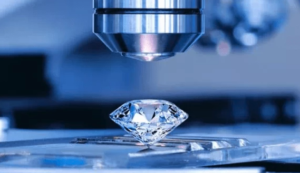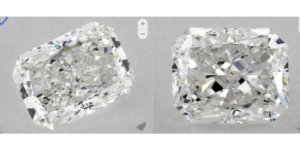- By Jacob Clarke
- jacob.clarke@teachjewelry.com
- Last Updated: November 4, 2023

Lab-grown diamonds have grown in popularity for engagement rings and other fine jewelry.
While natural diamonds are prized for their rarity, some consumers have opted for man-made versions because they appear identical to ones mined from the earth.
But if you’ve browsed selections of lab-grown diamonds at online or in-person jewelers, you’ve likely noticed they’re still expensive. In fact, it’s common to spend more than $1,000 on a lab-grown diamond when it’s for an engagement ring.
In this article, I’ll explain why lab-grown diamonds are so expensive, how their costs compare to natural ones, and ways to reduce the overall price of your diamond ring.
What’s the Process of Creating Lab-Grown Diamonds?
The first step to understanding costs associated with lab-grown diamonds is learning how they’re created.
There are two main processes used to produce them: Chemical Vapor Deposition (CVD) and High-Pressure High Temperature (HPHT).
CVD was developed in the 1980s.
First, a diamond seed is placed in a vacuum chamber. Carbon-rich gasses fill the chamber, which is heated to 1,500 degrees Fahrenheit. The result is a square-shaped crystal.
The manufacturer forms the diamond crystal into its final shape, such as a round, marquise, or radiant cut.

These diamonds are Type IIA, which are known as the most chemically pure.
So CVD diamonds often have high clarity and color grades.
HPHT diamonds is the original process used to create lab-grown diamonds. It was developed in the 1950s.
Similar to CVD, a diamond seed is set in carbon and exposed to intense heat and pressure.
When the carbon melts around the seed, it results in a man-made diamond.
The HPHT process more closely aligns with the process through which natural diamonds are formed.
The CVD and HPHT processes can take six to 10 weeks to go from the diamond seed to the final cut.
So one reason lab-grown diamonds carry a higher price tag than expected is because of the technology, time, and energy required to produce them.
But in the end, they appear identical to natural diamonds. To demonstrate, the image below features a lab-grown diamond created through HTPH, and the other is natural.

Even a professional gemologist couldn’t tell the diamond on the left was man-made.
How Much Do Lab-Grown Diamonds Cost?
The cost of a lab-grown diamond depends on several factors, so I’ll provide real-world examples of prices for specific ones as well as how the price changes depending on its qualities.
I analyzed prices for more than 200 lab-created diamonds from James Allen. They all had ideal cut grades.
The chart below shows average prices categorized by color and clarity grade.
As you can see, the cost generally rises as the color and clarity grades improve. This is because there’s higher demand for diamonds that appear colorless and don’t have visible inclusions.
Lab-grown diamonds aren’t only used in engagement rings. You’ll find them in jewelry such as necklaces, bracelets, and earrings.
The price of these pieces is strongly correlated with the diamond.
As an example, here’s a solitaire pendant with a 0.75-carat diamond that earned an VS or SI clarity grade and I or J color grade.
It costs $1,085.
I found this lab-created diamond from the same vendor with the same grades as the one in the pendant.
Its price is $769.
So the premium you’ll pay for the pendant over the loose diamond is $316, which represents 29 percent of the total price.
This demonstrates how the price of lab-grown diamond jewelry is dependent on the cost of each diamond in the piece.
How Does Price Compare to Natural Diamonds?
If you perceive lab-grown diamonds as expensive, you might be surprised to learn they cost significantly less than natural ones.
As a general rule, you can expect to pay 40-60 percent less for a lab-grown versus earth-mined diamond, but the specifics vary depending upon the vendor and quality.
To provide actual examples, I compiled prices for 373 one-carat natural diamonds from James Allen. They earned ideal cut, VS2 clarity, and D color grades.
The average price was $8,336, and the range was $6,470-$10,850.

For the lab-grown diamonds with those same cut, clarity, and color grades, the average was $1,747, with a range of $1,580-$1,780.
That’s a 79 percent savings for a lab-grown diamond compared to a natural one.
The same principle applies to fine jewelry crafted with a natural diamond. While the 0.75-carat pendant with a lab-grown diamond above costs $1,085, I found this comparable pendant with a natural one.
Its price is $2,890.
In the same way you pay more for natural loose diamonds compared to ones grown in a lab, that premium is added to other types of jewelry.
You should also know that lab-grown diamonds don’t retain their value to the same extent as natural diamonds.
They have minimal resale value because the same quality diamond can be reproduced in a lab.
Natural diamonds, on the other hand, do retain some value because of their rarity.
After purchase, you might find a jeweler willing to pay 50 percent of its original cost.
It’s another factor to consider as you weigh the price of a lab-grown diamond.
How to Reduce the Cost of a Lab-Grown Diamond Jewelry
If you’re finding that lab-grown diamond jewelry is too expensive, there are practical ways you can reduce the overall cost.
The most effective way is to find one with lower color and clarity grades that appears identical to ones that earned higher grades.
For each step up the color and clarity scales, you’ll pay 10 to 20 percent more. That difference isn’t always apparent to the naked eye.
Here’s a 0.75-carat diamond with D color and VVS1 clarity grades.
It costs $1,320.
While these grades ensure it won’t show any color or imperfections, it doesn’t offer the best value.
In fact, this 0.75-carat diamond will look identical when viewed without magnification. It earned F color and VS1 clarity grades, so it only costs $950.
That’s a savings of $370, or 28 percent, by choosing lower color and clarity grades.
The second way to reduce the cost of a lab-grown diamond ring is to split the total carat weight among multiple diamonds.
The price of diamonds doesn’t increase linearly. It’s exponential. A two-carat diamond costs more than double the price of two one-carat diamonds.
So instead of a solitaire setting with an expensive lab-grown diamond in the middle, consider a smaller diamond complemented by a halo, pave, or three-stone setting.
Check out this engagement ring with a pave setting.
It adds 0.17 carats to the diamond in a more cost-effective way than increasing the weight of the center diamond by that amount.
While you’ll save on price by choosing a man-made diamond compared to a natural one, these tips will help you reduce the cost even more so your lab-grown diamond jewelry isn’t so expensive.
Is a Lab-Grown Diamond Right for You?
Lab-grown diamonds are a trending alternative to the traditional choice of an earth-mined gem. Because the two types have the same properties, they appear identical.
This makes them an appealing option for those interested in an affordable piece of jewelry.
So while lab-grown diamonds may have a reputation of being expensive, it’s actually a way to save on the overall cost of the ring.
Explore a variety of lab-grown diamonds from quality jewelers. Pair them with your ideal setting, and you’ll discover the right piece for you.
The sophistication in technology employed in crafting lab-grown diamonds is what attributes to their price. However, when compared to the costs and environmental implications of mining natural diamonds, the price tag on lab-grown variants is justifiable. Plus, the ability to choose lower color and clarity grades without compromising the visual appeal provides a cost-effective solution for many buyers.
Chuck Harris, Educator at Teach Jewelry Tweet
Lab Grown Diamonds Q&A
Q: How does the technology used in creating lab-grown diamonds contribute to their price?
A: The technology, including Chemical Vapor Deposition (CVD) and High-Pressure High Temperature (HPHT) processes, requires significant investment in equipment and energy. The precision and conditions needed to create high-quality lab-grown diamonds contribute to their price.
Q: How does the environmental impact differ between lab-grown and mined diamonds?
A: Lab-grown diamonds are often marketed as an environmentally friendly alternative since they avoid the ecological damage associated with traditional mining. However, the energy consumption required for creating lab-grown diamonds can also have environmental implications.
Q: Can lab-grown diamonds be distinguished from natural diamonds without professional equipment?
A: It’s extremely difficult to distinguish between lab-grown and natural diamonds without professional equipment. Their physical and chemical properties are nearly identical, requiring specialized tools or expertise to differentiate them.

Jacob Clarke
Jacob Clarke is the founder of TeachJewelry.com.
He earned an Applied Jewelry Professional Diploma from the Gemological Institute of America (GIA) and now brings you essential information about diamonds, settings, and more.
Jacob has consulted with leading jewelry brands, and his work has been cited in Clean Origin, Diamond Nexus and industry publications.
He's also a member of the International Gem Society.
He enjoys discussing jewelry with readers, so contact him with any questions at jacob.clarke@teachjewelry.com.


















